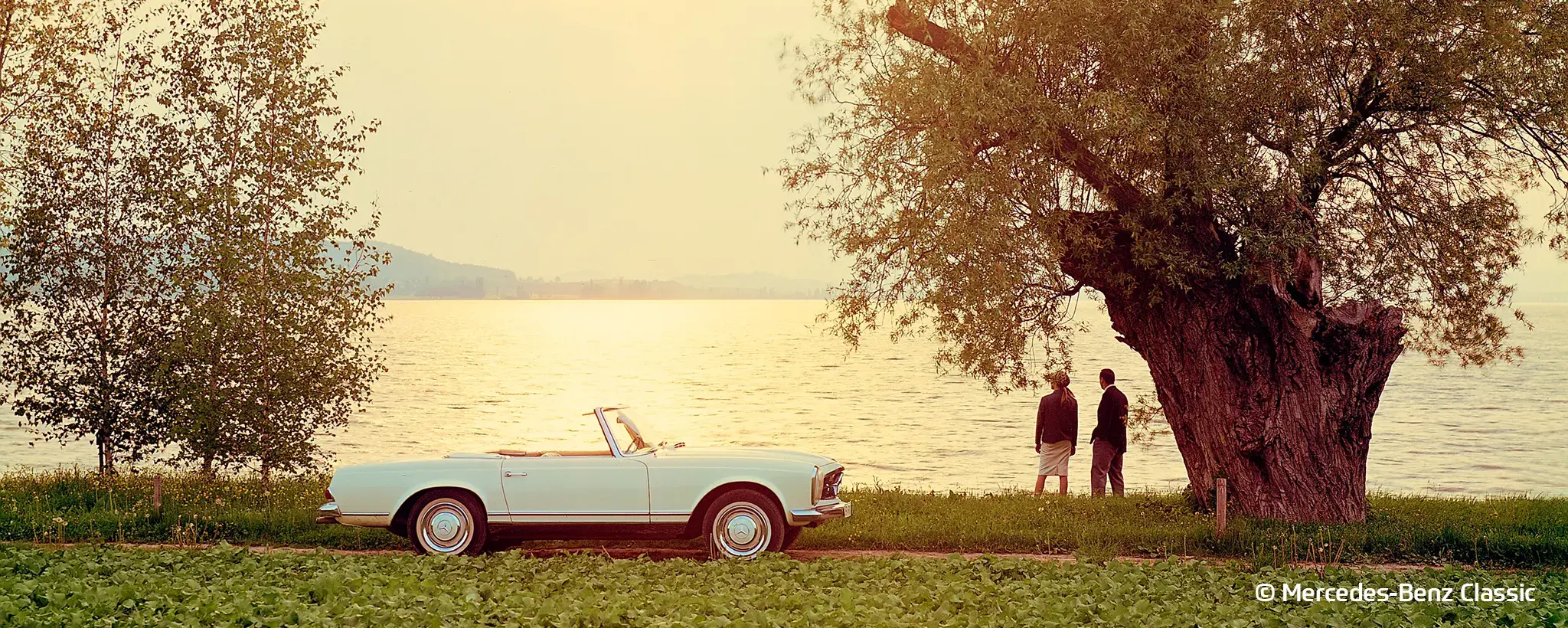

Mercedes-Benz Pagoda: A Masterpiece turns 60
It is a classic among roadsters and even more popular than ever after decades: the Mercedes Pagoda. It's hard to believe that this masterpiece of German engineering is 60 years old this year.
Is there anything better than gliding along in a stylish convertible and feeling the warm summer wind on your skin? For many car enthusiasts, there is nothing better. One vehicle is made for this like no other: the Mercedes Pagoda has fascinated drivers worldwide for six decades now. ZF has a special history with it, as the reproduction of the S5-20 five-speed transmission marked the birth of the historic spare parts supply at ZF.
The Mercedes Pagoda is not just a car, but a true design icon. It is characterized by its distinctive, rounded design with gently curved lines. Also known as the Mercedes-Benz W113, it was first unveiled at the International Motor Show in Geneva in 1963 and has since written an incomparable success story
A Milestone in the History of Automotive Design
It was created by Paul Bracq, one of the most important body designers in automotive history. The name "Pagoda" is derived from the shape of the hardtop roof, which is reminiscent of the roofs of traditional Asian pagodas. The elegant body concealed an advanced technology package, and ZF was not to be left out. It was equipped with ZF (formerly Fichtel & Sachs) shock absorbers and clutch as standard and the ZF S5-20 5-speed transmission was available as an option.

With its gently curved lines, the pagoda became a design icon.
However, only a few buyers recognized the advantages of the 5-speed transmission at the time and so over the decades there was increasing demand from owners for an updated version.
Almost 50 years later, ZF rebuilt the S5-20 in a limited number of units after a thorough examination of the requirements. Many customers who wanted more driving comfort and enjoyment thanks to lower revs and more economical consumption placed their orders. In an unprecedented joint campaign with the Mercedes-Benz Classic Center, the required number of units for the new edition was finally achieved.
What Is so Special About the S5-20?
The S5-20 could be described as revolutionary at the time because, in retrospect, it was around ten years ahead of its time in terms of its dimensions in terms of transmission development. At the time, the transmission was designed with two shafts (main and countershaft) in a classic design. With their large cross-section, the main and countershaft was a solid design. Overall, the S 5-20 was smaller than comparable gearboxes at the time and therefore a compact and solid design in a small installation space.
The short overall length caused quite a stir at the time. Compared to other gearboxes, a lot of power was transmitted to the wheels via the output flange and the cardan shaft. The length compensation in the output drive train of the S 5-20 is located on the cardan shaft and not in the transmission components.
The transmission is also characterized by its sturdy grey cast iron housing. The gear wheels have a solid cross-section, and the needle bearings are large in diameter. At that time, uniform bearings on the input and output sides were not always common. The use of identical synchronizer rings also reduces the variety of parts in the S5-20.

ZF W113 specially reproduced for the model range: The S5-20 five-speed transmission.
ZF Tradition Provides the Most Important Wearing Parts
Not only Pagodas can be converted with the replica of the ZF S5-20! The transmission was also suitable for conversion for the Mercedes-Benz 300 SE, SEb and SEL. The rebuild also ensured the supply of spare parts, as ZF had the most important wear and spare parts available, which were offered in the form of repair kits with synchronizer, bearing and seal sets.
In terms of technology, the Pagoda was one of the first production vehicles to be equipped with a safety body to better protect the occupants in the event of an accident.
Under the hood, it offered a wide range of powerful engines, from the 2.3-liter six-cylinder engine of the 230 SL to the powerful 2.8-liter engine with an output of up to 170 hp. These engines, and not least the optionally available ZF S5-20 gearboxes, delivered impressive performance and enabled the Pagoda to move confidently both on winding country roads and highways.

Always an eye-catcher: Mercedes-Benz Pagoda.
The Pagoda also featured a number of innovations, such as a safety steering column, an improved braking system (thanks to Mercedes' first dual circuit braking system), and a spacious, luxurious interior. Another remarkable feature of the Pagoda was its outstanding folding roof system. In just a few simple steps, the hardtop could be removed and replaced with a soft top, transforming the Pagoda into a stylish convertible. This flexibility made the Pagoda an ideal vehicle for all seasons and underlined its versatility.
The popularity of the Mercedes Pagoda remains unbroken to this day. It has been immortalized in films and music videos and remains a status symbol of style and class.
Happy Birthday, you beauty!















